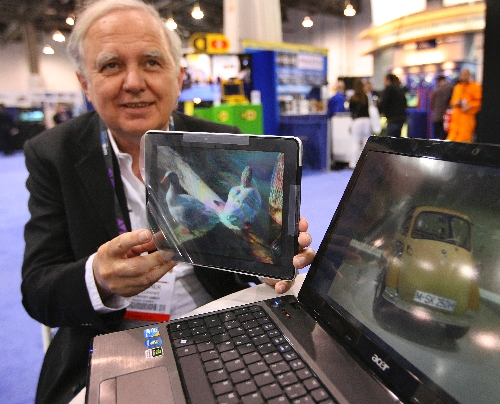National Association of Broadcasters boss defends use of spectrum
For several years, National Association of Broadcasters convention participants have raved about the coming of the "connected TV" as more than an instrument to receive network signals.
This year, the talk continues, but the idea has made little headway with viewers. Although industry experts say tens of millions of devices have been sold that could make the concept come true, few applications have taken hold beyond Netflix movies and TV shows carried over an Internet connection.
"All the terminology we have used has just confused consumers, let's start with that," said Wilfred Martis, general manager of retail consumer entertainment products for Intel Corp.'s Digital Home Group. "(And) I don't think anything interesting out there has appeared yet."
For a fresh start, Intel renamed its initiatives "smart TV." But it may not mean much until later in the year, when he said a new generation of devices will start to hit the shelves.
Despite connected TV's potential to reach viewers any place at any time, questions about how to compensate broadcasters for their programming still have not been settled, said Richard Buchanan, vice president of video services for the media center division within cable giant Comcast.
"Unless you have a (financial) ecosystem that provides for everybody on the food chain, you are constructing something that is very fragile," he said.
But at one panel discussion at NAB, which started Monday and ends Thursday, several audience members questioned whether broadcasters risked following in the steps of Blockbuster, which once dominated home video rentals but collapsed in bankruptcy as technology passed it by.
The expanding range of TV has sparked an unusual public feud between two of Las Vegas' largest annual conventions: NAB, with an estimated attendance of 90,000, and the International Consumer Electronics Show, which drew 140,000 in January.
To coincide the with opening of the NAB show, the Consumer Electronics Association, which stages CES, released a poll showing that only 10 percent of respondents received their breaking news from over-the-air broadcasts. The poll also showed that a large majority favored having the federal government auction off "underutilized" broadcast frequencies, some of which are now held by TV and radio stations.
Mobile devices that could play almost any type of programming were the starring attraction of this year's CES.
But in his state of the industry speech, NAB President Gordon Smith countered that broadcasting was a more efficient use of airwaves than mobile uses, such as data transmission to cellphones and iPads.
"So we are in full battle mode to protect broadcasters from being forced to give up spectrum involuntarily," he said.
As a show, the NAB has started to bounce back from the recession. This year, the trade show was expected to attract about 1,500 exhibitors taking up slightly more than 800,000 square feet. Although both marked single-digit percentage improvements from last year, they were still down from the 1,600 exhibitors and 900,000 square feet in 2009.
Displays of professional grade equipment such as set lights and microphones occupied much of the show floor. Companies including Canon and Panasonic constructed huge exhibits that included detailed sets, some with live models that let people run cameras through the courses.
Displays from other companies were much smaller. CineView 3D, a Las Vegas-based company, is distributing a low-cost system for adding 3-D to conventional monitors and TVs. In the system, developed by the German engineer, a plastic sheet placed over a screen or monitor can create a 3-D look when used along with special software.
The system will go on sale in May through the company's website at $95 for small screens. It is designed, CineView 3D director Stephen Scharren said, to enhance a picture without expensive hardware, such as glasses, that have hampered the rollout of conventional 3-D.
Contact reporter Tim O'Reiley at
toreiley@reviewjournal.com or 702-387-5290.






























